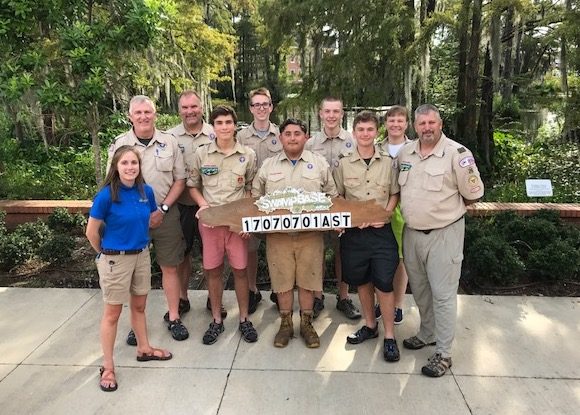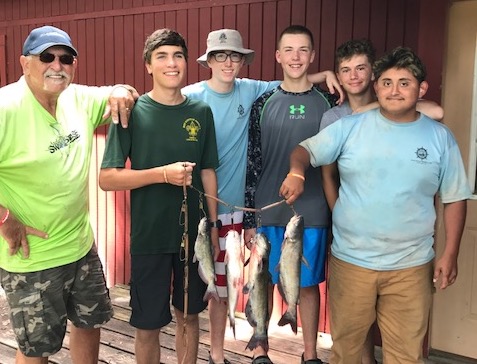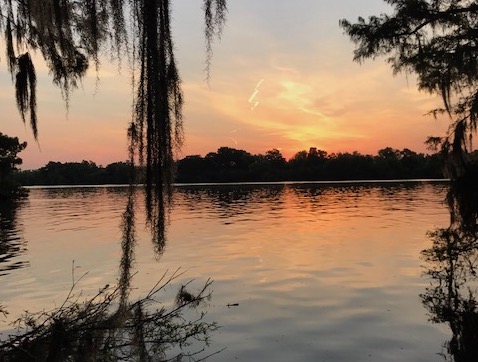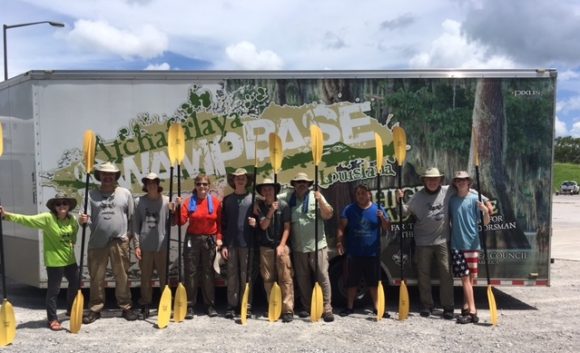
Editor’s Note: This personal account of the Swamp Base 2017 experience was submitted by Life Scouts Evan St. Louis and Theodore Wayland.
The steady lapping of our oars was only interrupted as we had to lean back in our canoe seats to avoid low branches, while we were keenly observed by the alligators swimming by …
On July 7, Lyme-Old Lyme Boy Scout Troop 26 became the first ever Connecticut troop to attend the Boy Scouts of America High Adventure called Swamp Base. This program is based at the Atchafalaya Swamps in southern Louisiana. On the day of our arrival, our crew of five scouts and four adult leaders visited the nearby town of Lafayette, to sample local cuisine and to become acclimated to the local temperature and humidity.
The next day, our first full day in the area, we traveled to a historical region called Vermilionville and learned about the Acadian culture of southern Louisiana. We met our guide for the trip, Brooke, a sophomore at the University of Louisiana at Lafayette (ULL.) That night we thoroughly checked all our equipment and provisions then fell fast asleep in the ULL dorms.

Our swamp venture began very early that next morning as we drove to a spot at the start of a canal and launched our canoes. The canal went on for 4.4 miles. At the end of the canal, it seemed as though there was a wall of trees, and that section of paddling was aptly called “The Wall” by our guide. That area was perhaps the most challenging section of the whole trip. There were trees and shrubs very close together, and you had to stay in the middle of the waterway to avoid wasp nests.
Thankfully, we made it through this section unscathed and there were no wasps anywhere else on the trip.
After the narrows opened up into the Henderson Swamp, there was much more room to maneuver. The first day we traveled 19.3 miles to houseboats where we would be sleeping. The Henderson swamp had areas where the Cypress trees were logged over 100 years ago, and any trees that are left were considered the runts back then.
Our houseboat captain gave a fascinating overview on the alligators of the Bayous, and their role in the environment. At this point, we had seen enough alligator behavior to realize that they are more scared of us then we were of them, and would try to avoid us.
The next morning, we had an exciting airboat tour of the outlying areas of Henderson Swamp where cypress trees grew in groves. It truly is amazing that the Cypress trees can grow in over six feet of water. After all of the beautiful sights on the airboat tour, it would be back to traveling under our own power.
This day we would cover 10.3 miles; however, after paddling only about a mile from the houseboats, we had to portage our canoes over a levee. This portage was 900 feet long and over the 25-foot-tall levee, but with the extra weight of gear and canoes, it felt much longer. The late morning heat was near its peak adding to the challenge of this portage. After that, the paddle was nice and slow with a wide-open waterway, with plenty of shade from the heat.
That night, we slept on Rougarou Island in hammocks covered with mosquito-netting. The Rougarou was a creature similar to a werewolf in the legends of the Laurentian French communities – fortunately there were no modern versions present during our trip! We also had a blowgun contest with very basic materials – this was fun, but may not have provided us too much security if a Rougarou showed up.
Our next day of paddling was 14.4 miles and not too difficult, but the wildlife was probably the most diverse that we saw throughout our trip. We saw a wide variety of birds and plants in different areas, and quite a few alligators, the most on any day of our journey. Midday of this paddle, it began pouring with rain, and there was an interesting sight of the giant raindrops bouncing on the water as they hit it, but multiplied millions of times. This was the point we were really glad to have dry bags, so none of our gear got wet.
After the rain stopped, we still had to cross two lakes, which were strenuous, but we knew how close Island Outpost was, our final stop. Once we arrived, the Boy Scout crew that had arrived the previous day helped us get our canoes onto the dock. On Island Outpost, there were showers, and clean water was readily available. We would be sleeping in cabins for two nights, on bunks in rustic cabins, after enjoying our jambalaya dinner prepared for us.

The next day at Island Outpost we had no paddling and enjoyed other relaxing activities including swimming, boating, and paddle boarding. There were fishing trips by boat, and setting out catfish jug lines. After later checking the jug lines to harvest our catch, we enjoyed a catfish fry that would be a side to gumbo for dinner with plentiful Cajun spice to notch up the heat.
The morning of the last day, we woke up before 5 a.m. to be able to see the sunrise at 6:13 a.m. on Sandy Cove from a great vantage point. We were in the water at about 5:30 a.m. and started immediately. We made it to the outlook point just in time, because within a minute of us arriving, the top of the sun had started to peek above the horizon. It was definitely worth waking up for, to see the sun climb up into the sky rapidly.

After eating breakfast on the water, we continued paddling, trying to get to the next scheduled portage early before it got too hot. We went in between ancient Cypress trees on the edge of Lake Fausse Pointe. There were a few alligators there that were very close to us. It was fabulous here too in terms of both the view and the overall cleanliness of the area.
The second portage was easier than the first, except for the very end. The end of the second portage, behind the levee, was referred to as the “Swamp Stomp” – an area several hundred-feet long where there was thick mud and certain areas of waist-high water that we had to wade through pulling our canoes. Once we were through the Swamp Stomp, we came out onto a chilly river.
This part of our trek was the easiest, because there was a current that carried us almost the whole way to the end of our journey. We had gone swimming off the canoes from time to time on previous days of the trip, but with this current it was not necessary to paddle as much, and at this time it was much more refreshing and enjoyable to be in the water.

At the end of our paddling adventure, we had completed 61.6 miles of canoeing the swamps and lakes of this amazing area over five days. We had a sense of accomplishment at completion, and all of us agreed if offered the chance to conquer the Swamp again, we would be there!
Y’all come back now, won’t ya?!
I recognize you guys! You were at Island Outpost when our Crew from Everett, WA was there. Very nice write up of the trip.
We. We’re the first crew to tackle the swamp this year and would like to say the staff and the trip was awesome . The shear beauty of the area and the history is fantastic .Ifyou get the chance do this trip you will not regret it .t